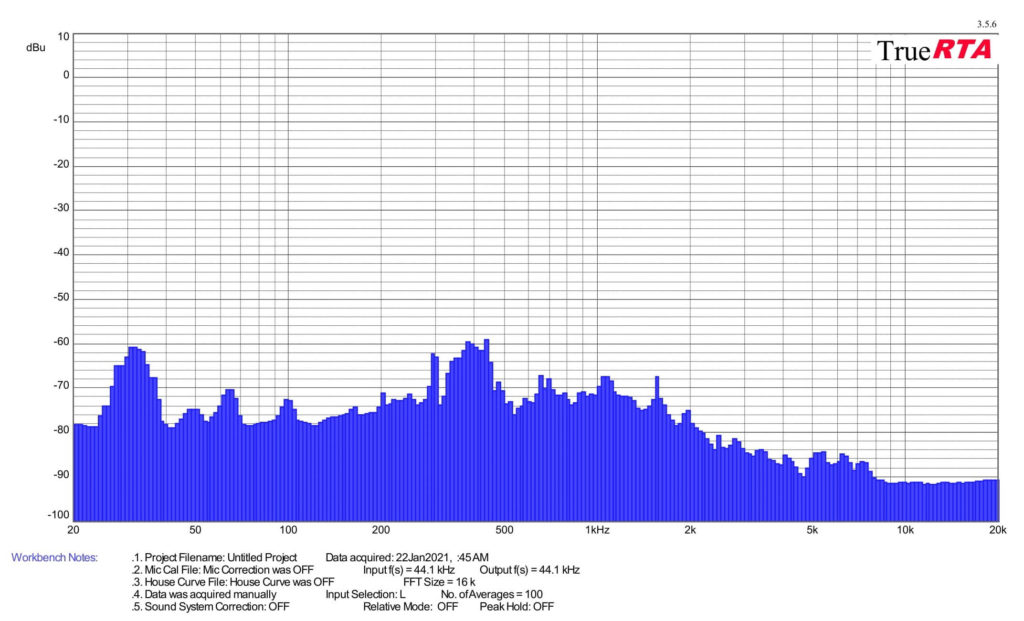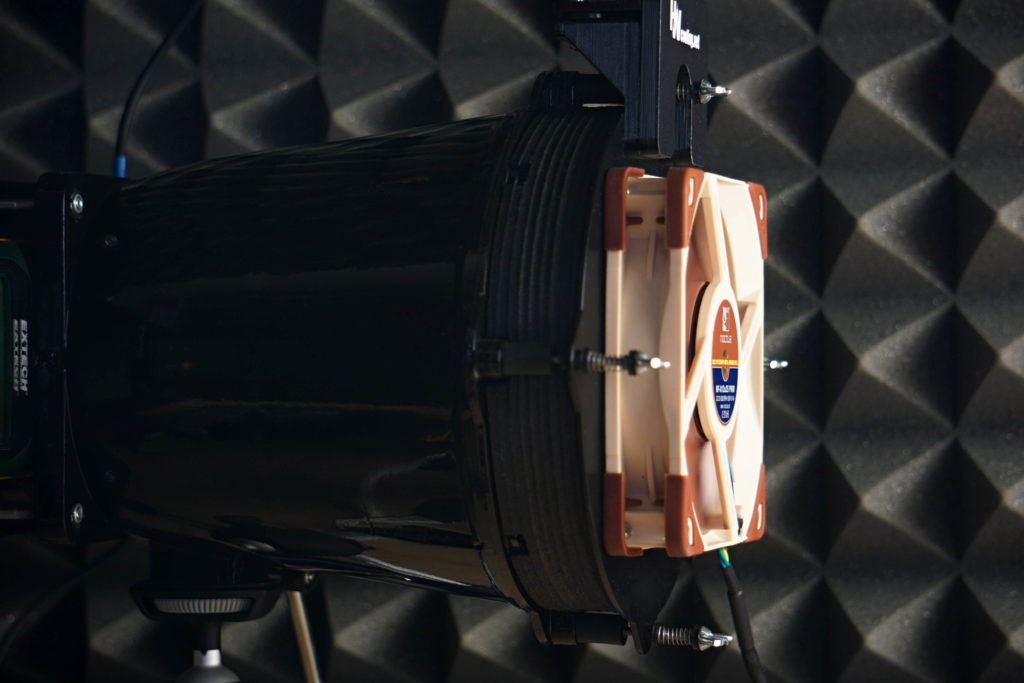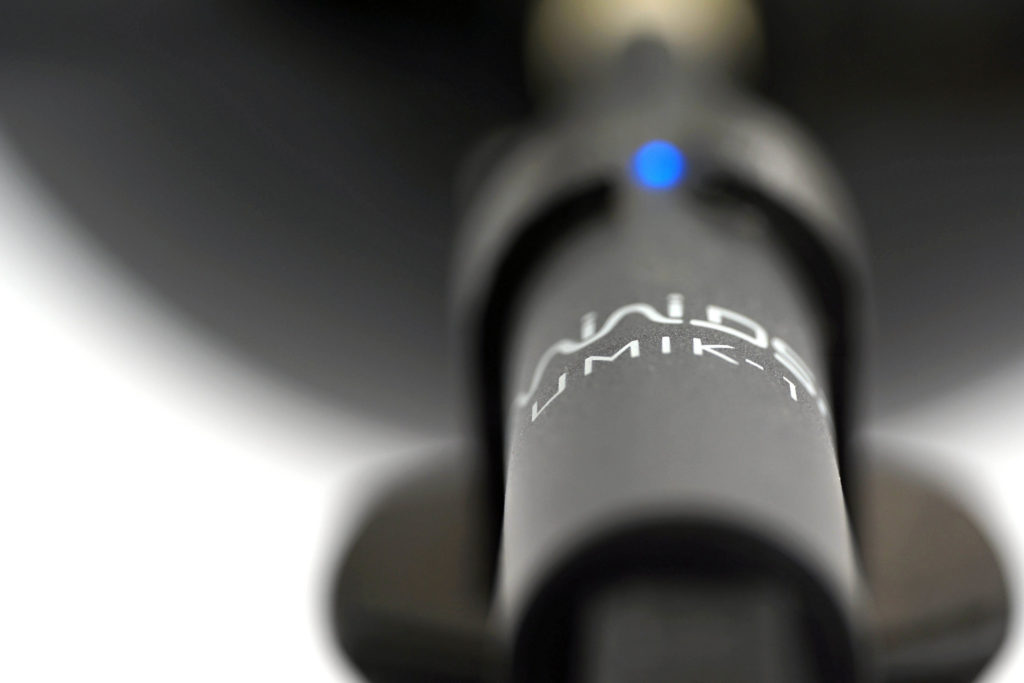... and sound color (frequency characteristic)
Longer life in exchange for more noise? These are also some of the agenda items we’ll cover in our comparison of the Arctic P14 CO fan with the fluid bearing variant. These are actually the main points. In any case, the ball bearings in the more expensive variant of these fans also have specific features that can be easily observed and distinguished even in normal, “home” use.
33 dBA or 33 dBA
The noise level, given as a single dBA value, is good for quick reference, but it doesn’t give you an idea of exactly what the sound sounds like. That’s because it averages a mix of noise levels of all frequencies of sound. One fan may disturb you more than the other, even though they both reach exactly the same dBA, yet each is characterized by different dominant (louder) frequencies. To analyze thoroughly with an idea of the “color” of the sound, it is essential to record and assess noise levels across the entire spectrum of frequencies that we perceive.

We already do this in graphics card tests, and we’ll do it for fans too, where it makes even more sense. Using the UMIK-1 miniDSP microphone and TrueRTA’s mode-specific, fixed dBA application, we also measure which frequencies contribute more and which contribute less to the sound. The monitored frequency range is 20-20,000 Hz, which we’ll work with at a fine resolution of 1/24 octave. In it, noise levels from 20 Hz to 20 000 Hz are captured at up to 240 frequencies.
The information captured in the spectrograph is a bit more than we will need for clear fan comparisons. While you’ll always find a complete spectrograph in the tests, we’ll only work with the dominant frequencies (and their noise intensities) in the low, mid, and high bands in the comparison tables and charts. The low frequency band is represented by 20–200 Hz, the medium by 201–2000 Hz and the high by 2001–20 000 Hz. From each of these three bands, we select the dominant frequency, i.e. the loudest one, which contributes most to the composition of the sound.
To the dominant frequency we also give the intensity of its noise. However, in this case it is in a different decibel scale than those you are used to from noise meter measurements. Instead of dBA, we have dBu. This is a finer scale, which is additionally expressed negatively. Be careful of this when studying the results – a noise intensity of -70 dBu is higher than -75 dBu. We discussed this in more detail in the article Get familiar with measuring the frequency response of sound.
Strict acoustic safeguards are required to ensure that these measurements can be carried out with satisfactory repeatability at all. We use acoustic panels to measure the same values at all frequencies across repeated measurements. These ensure that the sound is always reflected equally to the microphone regardless of the distribution of other objects we have in the testlab. The baseline noise level before each measurement is also naturally the same. The room in which we measure is soundproofed.

Like the noise meter, the microphone has a parabolic collar to increase resolution. The latter is specially in this case not only to amplify but also to filter out the noises that occur whether we want them or not behind the microphone. We are talking about the physical activity of the user (tester). Without this addition, human breathing, for example, would also be picked up by the spectrograph. However, this is successfully reflected off the microphone sensor by the back (convex) side of the collar. As a result, the spectrogram only contains information about the sound emitted by the fan itself.
- Contents
- Arctic P14 PWM PST CO in detail
- Overview of manufacturer specifications
- Basis of the methodology, the wind tunnel
- Mounting and vibration measurement
- Initial warm-up and speed recording
- Base 6 equal noise levels…
- ... and sound color (frequency characteristic)
- Measurement of static pressure…
- … and of airflow
- Everything changes with obstacles
- How we measure power draw and motor power
- Measuring the intensity (and power draw) of lighting
- Results: Speed
- Results: Airlow w/o obstacles
- Results: Airflow through a nylon filter
- Results: Airflow through a plastic filter
- Results: Airflow through a hexagonal grille
- Results: Airflow through a thinner radiator
- Results: Airflow through a thicker radiator
- Results: Static pressure w/o obstacles
- Results: Static pressure through a nylon filter
- Results: Static pressure through a plastic filter
- Results: Static pressure through a hexagonal grille
- Results: Static pressure through a thinner radiator
- Results: Static pressure through a thicker radiator
- Results: Static pressure, efficiency depending on orientation
- Reality vs. specifications
- Results: Frequency response of sound w/o obstacles
- Results: Frequency response of sound with a dust filter
- Results: Frequency response of sound with a hexagonal grille
- Results: Frequency response of sound with a radiator
- Results: Vibration, in total (3D vector length)
- Results: Vibration, X-axis
- Results: Vibration, Y-axis
- Results: Vibration, Z-axis
- Results: Power draw (and motor power)
- Results: Cooling performance per watt, airflow
- Results: Cooling performance per watt, static pressure
- Airflow per euro
- Static pressure per euro
- Results: Lighting – LED luminance and power draw
- Results: LED to motor power draw ratio
- Evaluation













Expected results, but still an interesting showcase of the effect of only changing the bearings.
So, the “hum” is still here all the same, despite some claims that the CO version fixes it. ThermalLeft has documented sound differences between revisions too (https://www.youtube.com/watch?v=nt8Ao4GDmzY), but even Arctic themselves doesn’t think revisions will have such an effect. I am starting to think it’s possibly a batch “issue” that may have introduced different properties to the rotor material.
I guess those claims of the CO rumbling less will never come from an official source (from Arctic)? They don’t seem to list among the changes across the revisions the modifications that address this. And personally, I don’t even see the technical reason behind the CO variant or the higher P14 revision (2 vs. 4) being quieter on lower frequencies. The impeller seems to have the same parameters in terms of geometry or material used. Nevertheless, there can certainly be a situation where different noise levels are measured across different fans. But it may not be due to different revisions, and perhaps it may be possible to observe this across different fan pieces of the same revision due to different manufacturing tolerances (which are high in the low-end after all)?
An analysis that tracks the tonal peaks of multiple pieces from the same revisions on each side would shed more light on this. From our experience, we note that the shape of the spectrograms of multiple pieces of the P14 PWM PST rev. 4 compared to P14 PWM PST CO rev. 3 in the low frequency band is identical at the same speed. The small differences in the spectrograms that you see in the tests are mainly just due to the fact that in modes normalized by the same noise levels, the speeds of the two variants (P14 and P14 CO fans) are slightly different. For the CO, the speeds are always set a little lower due to the noisier bearings.
Perhaps what is known as “resonance” is something else that’s not the frequency spike at ~100 Hz. Namely, the sudden increase in noise at specific RPM ranges. Or, perhaps the two issues are lumped together when people talk about it, when in fact the two (sound profile with pronounced low frequency peak, and some RPM ranges being suddenly louder) are different issues (that perhaps are related).
I am sure you would have noticed and mentioned it though, when you’re testing the fans and adjusting the fan speeds again and again.